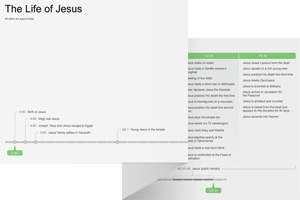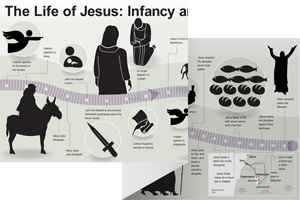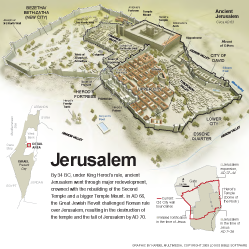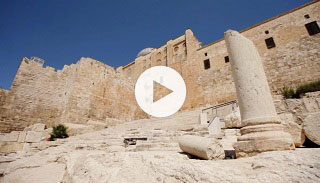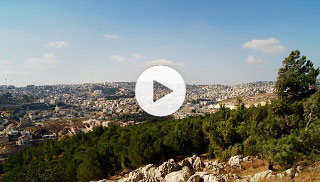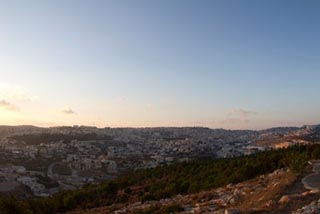1:1–18 The Gospel of John |
 The Gospel of John and the Johannine Letters
The Gospel of John and the Johannine Letters
1:1 In the beginning John begins by quoting the opening words of Genesis in Greek (Gen 1:1). He uses Genesis 1:1–5 to establish the “Word” as a preexistent agent of creation present with Yahweh from the beginning.
the Word John uses the term “Word” as a title for Jesus throughout this prologue. He doesn’t specify that “Word” refers to Jesus until John 1:17. The Greek term used here, logos, had a rich network of associations in the Hellenistic Judaism of the first century ad due to its ability to evoke both biblical and philosophical concepts.
had a rich network of associations in the Hellenistic Judaism of the first century ad due to its ability to evoke both biblical and philosophical concepts.
the Word was with God This phrasing testifies to the distinction between God the Father and Jesus while emphasizing the intimate relationship between the Father and the Son.
the Word was God The Word shares the same character, quality, and essence of God. John’s phrasing preserves the distinction between God the Father and God the Son while emphasizing their unity in all other regards.
1:3 All things came into being through him The concept of creation through the divine Word reflects Yahweh’s act of speaking the universe into existence in Gen 1:3–26. Jesus’ preexistence and role as Creator and sustainer of all things is also seen in Col 1:15–20.
1:4 In him was life The Word is the source of life, both physical through the creation of all things (looking back to John 1:3; compare Col 1:17) and spiritual (looking ahead to John 1:4; compare 6:35).
the life A key word for John; it is used 36 times in the Gospel. This Gospel and other nt writings associated with John account for more than 40 percent of the total occurrences of this word in the nt. For John, Jesus’ ability to grant life to those who walked in “darkness” or “death” is the key issue at stake. Jesus has the ability and authority to do so because He was there in the beginning when God’s creative works took place.
was the light of humanity John alludes to the initial act of creation involving light (Gen 1:3) and invokes the association of light with divine glory (Isa 60:19). Light is often used in the ot as a metaphor for salvation and spiritual awakening (see note on Isa 51:4).
humanity This Greek term can refer generically to the human race. That this is a reference to all humanity is made clear from Jesus’ statement in John 8:12. Compare the “light for the nations” idea in Isa 42:6; 49:6.
1:5 the light shines in the darkness The contrast between light and darkness is a prominent theme in John’s Gospel (compare John 1:8–10; 1 John 2:8–10). This antithesis draws on Gen 1:1–5 (see note on John 1:1) as well as ot traditions of the advent of the Messiah as a light dawning over a world of physical and spiritual darkness (e.g., Isa 9:2; 60:1–2).
overcome A variety of figurative senses are available for the Greek verb used here, katalambanō—which means “take hold of” or “seize”—making its meaning ambiguous.
1:6 whose name was John Introduces John the Baptist as the messenger sent by God to announce the coming of His salvation into the world through Jesus. John was the prophesied forerunner of the Messiah (see Mal 4:5–6; compare Matt 11:9).
as the messenger sent by God to announce the coming of His salvation into the world through Jesus. John was the prophesied forerunner of the Messiah (see Mal 4:5–6; compare Matt 11:9).
Luke records the angelic announcement of John’s miraculous birth to Zechariah and Elizabeth in their old age (Luke 1:5–25). John’s ministry began around ad 29 in the Judaean wilderness along the Jordan River (Luke 3:1–3; Matt 3:1–2). John’s patterning after Elijah extended even to his dress and his penchant for isolation in the wilderness. John wore a garment of camel hair with a leather belt, reminiscent of Elijah’s clothing from 2 Kgs 1:8 (see Matt 3:4; Mark 1:6). His primary message was calling Israel to repentance in preparation for the coming of the messianic age (Matt 3:2; Mark 1:4; Luke 3:3). John was arrested and imprisoned by Herod Antipas for criticizing his marriage to Herodias, Herod’s brother’s ex-wife, which was unlawful under Jewish law (see Lev 18:16; Matt 14:3–4; Mark 1:14; Luke 3:19). Eventually, Herod had John beheaded (Matt 14:5–12). John the Baptist also is mentioned by Josephus, a first-century ad Jewish historian who recounts John’s ministry and unjust execution (Josephus, Antiquities 18.116–119). |
1:7 a witness John’s mission is articulated in legal terms; he is a witness coming to testify. The imagery also is used in Isaiah, where God’s people testify to His sovereignty (see Isa 43:10; 44:8).
all would believe through him The preaching of John the Baptist was intended to inspire faith in God by pointing people to Jesus as His supreme act of providence. God doesn’t send a messenger; He sends His very Son, the means of creation itself.
1:9 true light Alluding to the Messiah. See John 1:5 and note.
1:10 the world The Greek word used here, kosmos, occurs 78 times throughout John’s Gospel. Sometimes it refers broadly to the whole created order (11:27; 21:25), but most of the time it refers specifically to humanity in rebellion against God and hostile to Christ (7:7; 12:31; 14:17; 15:18–19; 16:20; 17:14, 25).
1:11 his own people did not receive him Not only did the entire world not recognize its Creator (v. 10), but God’s chosen people rejected their Messiah.
1:12 children of God Unlike the people who rejected Him (John 1:11), those who accepted Jesus as Messiah are the true “children of God” (compare 3:3–8; 1 John 5:1).
believe in his name A particular idiom for faith in Christ used in John’s Gospel and 1 John (1 John 5:13).
1:13 not of blood See John 3:3 and note.
1:14 the Word became flesh Continues the symbolism of v. 1 by describing how the logos took on human form (see note on v. 1).
took up residence The Greek verb used here literally means “to dwell in a tent” and likely alludes to the ot tabernacle as God’s dwelling among His people (see Exod 33:7–11; note on Exod 27:21). Through His Son, God is taking up a post among His people just as He had done for ancient Israel.
as God’s dwelling among His people (see Exod 33:7–11; note on Exod 27:21). Through His Son, God is taking up a post among His people just as He had done for ancient Israel.
his glory Alludes to the manifestations of divine glory in the ot. Yahweh’s presence could be found in the tabernacle or temple (Exod 40:34–38; Num 14:10; 1 Kgs 8:10–11; Isa 6:1).
 Theophany in the Old Testament
Theophany in the Old Testament
 Doxa Word Study
Doxa Word Study
glory as of the one and only from the Father Emphasizing that the glory of Jesus, the Word, is the same as the glory of God the Father. The Greek term monogenēs, meaning “one and only” carries the sense of uniqueness and special beloved status (compare Heb 11:17). See note on John 3:16.
grace and truth Alluding to two central attributes of the divine character used throughout the ot: steadfast love and faithfulness. Jesus embodies the ultimate expression of God’s covenant loyalty and unmerited favor toward the world that rejected Him. See Exod 34:6 and note; compare Isa 54:10 and note.
1:17 the law was given through Moses John contrasts Moses with Jesus, emphasizing the superiority of the gospel of Christ to the law of Moses. Throughout his Gospel, John presents Jesus as the fulfillment of ot expectations. Compare John 5:46–47.
1:18 the one and only This same Greek term is used in v. 14 (see note on v. 14). The world will fully see God only as revealed through Jesus (14:6–9).
1:19–12:50 The first half of John’s Gospel is sometimes referred to as the Book of Signs, as it centers on the miracles Jesus performs as proof that He is the Son of God (e.g., 2:11; 4:54). This section deals with the public ministry of Jesus, culminating in the triumphal entry of Jesus into Jerusalem a week before Passover (12:12–19). The remainder of the Gospel focuses on the last week of Jesus’ life. |
1:19–51 The preaching of John the Baptist and his baptism of Jesus marks the beginning of Jesus’ public ministry, just as in the Synoptic Gospels (compare Matt 3; Mark 1; Luke 3). The first disciples also join Jesus during this time. Unlike the Synoptics, John has no account of Jesus’ temptation in the wilderness (Mark 1:12–13). |
1:19 the Jews Refers to the religious leaders in Jerusalem. John often uses this label to categorize those who are opposed to Jesus and His ministry (e.g., John 5:16; 11:57). While the term can be used in a neutral or even a positive sense (e.g., 2:6; 4:22), the prevailing connotation with the expression is “unbelieving Jews.”
Jerusalem The chief city of Judaea, the site of the Jewish temple, and the ancient capital of Israel and Judah.
priests and Levites The official religious leaders in charge of the temple in Jerusalem. See Deut 18:1 and note.
Who are you John answers their real question, “Are you the Messiah?” His answer indicates that their question was centered on their ot messianic expectations. See note on John 1:21.
1:20 I am not the Christ The Greek word used here, christos (meaning “anointed one”), is equivalent to the Hebrew term mashiach, meaning “Messiah.” John the Baptist is explicitly denying that he is the Messiah, but their questioning continues through multiple layers of Jewish messianic expectation. See note on v. 21.
but their questioning continues through multiple layers of Jewish messianic expectation. See note on v. 21.
1:21 Are you Elijah The prophet Elijah’s miraculous ascent into heaven on a fiery divine chariot (2 Kgs 2:11) fueled the belief that he would return as a forerunner of the Messiah. The ot explicitly attests to this expectation in Mal 4:5.
I am not John’s denial of the role of Elijah as forerunner of the Messiah likely reflects either his historical perspective on his ministry or an avoidance of traditional labels. The Synoptic Gospels explicitly connect John the Baptist with the expected coming of Elijah (see Matt 11:11–14; Luke 1:17).
Are you the Prophet This line of questioning reflects the varying categories of messianic expectation in the Second Temple period. Since John denied being the Messiah or his forerunner, Elijah, he is asked whether he is the prophet Moses predicted in Deut 18:15–18. John disclaims this role as well, showing complete humility in his calling. He understands that his office is to point to the Messiah and lead people to repent.
1:23 one crying out John identifies himself by quoting Isa 40:3. All four Gospels apply this Scripture to John the Baptist, but John’s Gospel is the only one that puts the quote on the lips of John the Baptist himself (compare Matt 3:3; Mark 1:3; Luke 3:4).
1:24 Pharisees A Jewish lay movement of experts in the interpretation of the law.
 Major Groups in Jesus’ Time Table
Major Groups in Jesus’ Time Table
1:25 Why then are you baptizing They ask John by what authority he has taken it upon himself to baptize Jews. Washing with water was a common practice in Jewish ritual purification, but baptism was associated with the conversion of Gentiles. See note on John 7:32.
1:27 the one who comes after me The Messiah. Compare John 1:15. John did not yet know exactly who this was (vv. 29–31).
untie the strap of his sandal In Jesus’ time, untying someone’s sandals was a menial job reserved for slaves. John’s humble statement places himself below the lowest of slaves in comparison to Jesus.
1:28 Bethany on the other side of the Jordan The location of this Bethany is uncertain, but it is different from the Bethany near Jerusalem (11:18; 12:1). It might be located in the region of Batanea (ot Bashan).
1:29 Lamb of God who takes away the sin An allusion to the symbolism of the Passover lamb (Exod 12:3). Compare Isa 53:7, 11; Rev 5:6.
1:30 This one is the one Connecting Jesus with his earlier announcements (see vv. 15, 27).
1:31 revealed to Israel The purpose of John’s ministry was preparing the way for the coming of the Messiah. The Gospel of John tends to use “Israel” as a positive label for God’s chosen people, identified ultimately by their beliefs, not ancestry (see note on v. 19).
1:32 the Spirit descending like a dove from heaven Jesus’ baptism is depicted more fully in Matt 3:13–17 and Luke 3:21–22. Here, John the Baptist simply testifies as a witness to the event. The event itself is spoken of in the past tense.
1:33 I did not know him John did not know Jesus was the Messiah until God revealed it to him. Compare John 1:27, 31.
1:34 testify See note on v. 7. John the Baptist is functioning as a formal legal witness to Jesus’ identity.
1:35–51 This account of the call of Jesus’ disciples differs from that of the Synoptic Gospels (compare Matt 4:18–22; Mark 1:16–20; Luke 5:1–11). For example, John gives a more detailed account of the call of Philip |
1:37 the two disciples Jesus’ first disciples were followers of John the Baptist. One of these disciples is identified as Andrew (John 1:40), but the other remains anonymous.
1:38 Rabbi A Hebrew title originally meaning “my master” but eventually taking on the sense of “authoritative religious teacher.”
1:39 the tenth hour The Greek text identifies the time as the “tenth hour.” The hours were typically counted from sunrise to sunset, generally 6 a.m. to 6 p.m. The tenth hour would be 4 p.m. It is possible that John used the Roman reckoning, counting the hours from midnight. In that case, the time would be around 10 a.m. This is unlikely to be correct, however.
1:40 Andrew, the brother of Simon Peter See Matt 4:18–22 and note.
1:41 We have found the Messiah John is the only nt writer to use the word messias, transliterating the Hebrew word mashiach into Greek. While John uses several Hebrew and Aramaic terms, he is careful to explain their meaning to his Greek audience. “Messiah” is the Hebrew equivalent of the Greek term christos, or “Christ.” See note on John 1:20.
1:42 Cephas Aramaic for “rock,” translated to Greek as petros or Peter. This renaming of Simon takes place later in Jesus’ ministry according to Matthew (Matt 16:16–18).
1:43 Galilee The northern region of Israel, along the Sea of Galilee. The towns of Bethsaida, Capernaum,
Capernaum, Nazareth,
Nazareth, and Tiberias
and Tiberias are all in this region and feature prominently in Jesus’ ministry.
are all in this region and feature prominently in Jesus’ ministry.
Philip The other Gospels mention Philip only in lists of the Twelve; John’s Gospel gives Philip a greater role (John 6:5–7; 12:20–26; 14:8–9).
only in lists of the Twelve; John’s Gospel gives Philip a greater role (John 6:5–7; 12:20–26; 14:8–9).
1:44 Bethsaida A fishing town on the northeastern shore of the Sea of Galilee.
1:45 Nathanael Not mentioned as one of the Twelve in the Synoptic Gospels, but usually identified with Bartholomew (whom John never mentions by name). “Nathanael” means “God has given.”
the law, and the prophets This phrase was a common way of referring to the entire Hebrew Scriptures (compare Matt 5:17; 22:40). Moses is traditionally connected with the Law in biblical tradition (see 1 Kgs 2:3; Ezra 3:2; Neh 13:1; Dan 9:11; Matt 8:4; Mark 12:26).
 Jesus’ Fulfillment of Old Testament Prophecy Table
Jesus’ Fulfillment of Old Testament Prophecy Table
Jesus son of Joseph Unlike Matthew and Luke, John does not provide an elaborate genealogy for Jesus (Matt 1:1–17; Luke 3:23–38). Here, He is identified in the traditional way with His earthly father’s name and hometown.
Nazareth A town in Galilee about 15 miles west of the Sea of Galilee.
in Galilee about 15 miles west of the Sea of Galilee.
1:47 true Israelite See note on John 1:31. John uses “Israel” and “Israelite” as positive terms for followers of God.
1:49 you are the Son of God The first confession of Jesus’ divine role as the Messiah by one of His disciples (compare Matt 14:33). See note on John 1:41.
You are the king of Israel See note on v. 31. Nathanael acknowledges Jesus as the rightful king of Israel, a role that legitimately belonged only to the Messiah.
1:51 Truly, truly A common expression in the Gospels to introduce Jesus’ teaching or a traditional saying. The phrase seems to function to emphasize the importance of what Jesus is about to say.
in the Gospels to introduce Jesus’ teaching or a traditional saying. The phrase seems to function to emphasize the importance of what Jesus is about to say.
you will see heaven opened See Ezek 1:1 and note.
the angels of God ascending and descending Alludes to Gen 28:12, representing Jesus as the embodiment of all earthly access to the divine realm.
the Son of Man A messianic title that Jesus often uses for Himself (see note on Matt 8:20; note on Dan 7:13). The title
that Jesus often uses for Himself (see note on Matt 8:20; note on Dan 7:13). The title also can mean “human one” (see note on Ezek 2:1). Here, Jesus may be acknowledging His humanity; this would parallel John 1:14. Jesus does this so that He can become the sacrifice prophesied by John the Baptist (see note on v. 29).
also can mean “human one” (see note on Ezek 2:1). Here, Jesus may be acknowledging His humanity; this would parallel John 1:14. Jesus does this so that He can become the sacrifice prophesied by John the Baptist (see note on v. 29).

|
About Faithlife Study BibleFaithlife Study Bible (FSB) is your guide to the ancient world of the Old and New Testaments, with study notes and articles that draw from a wide range of academic research. FSB helps you learn how to think about interpretation methods and issues so that you can gain a deeper understanding of the text. |
| Copyright |
Copyright 2012 Logos Bible Software. |
| Support Info | fsb |
 Loading…
Loading…


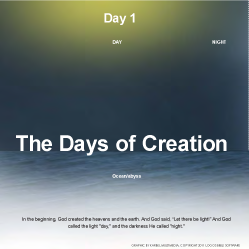
 John the Baptist
John the Baptist 